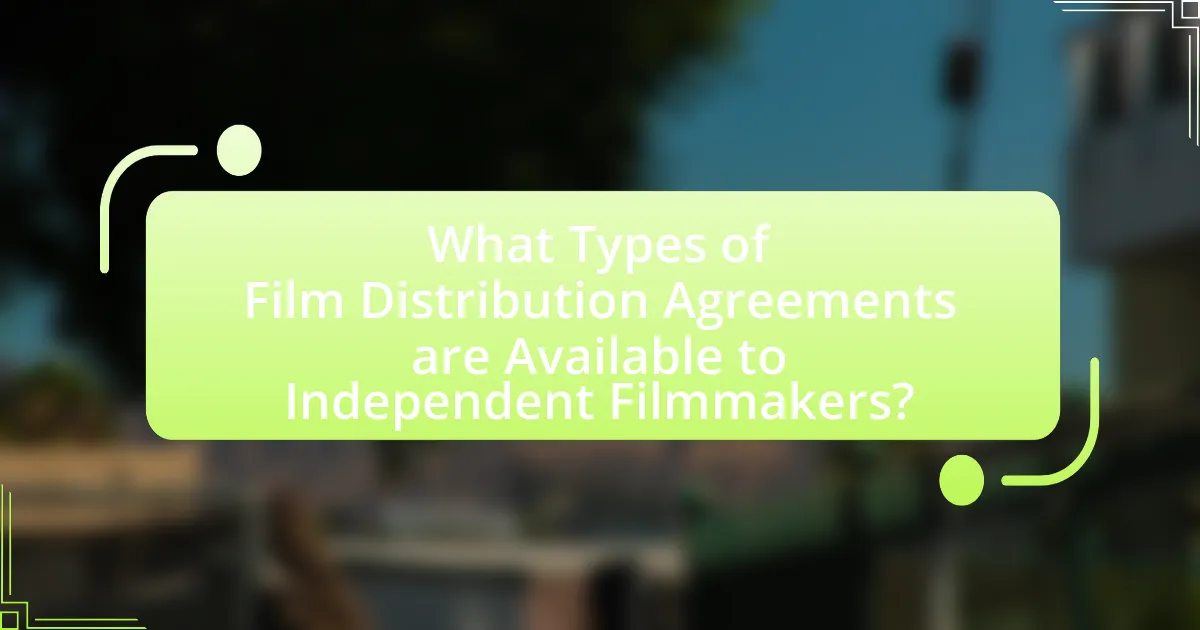Film Distribution Agreements are essential legal contracts that define the terms for distributing films, particularly for independent filmmakers. These agreements outline critical elements such as rights, revenue sharing, and marketing responsibilities, which directly impact a film’s visibility and profitability. The article explores the various types of distribution agreements available, the importance of negotiating favorable terms, and the potential risks of inadequate agreements. It also highlights best practices for filmmakers to protect their intellectual property and navigate the complexities of distribution, emphasizing the significant role these agreements play in the financial success of independent films.

What are Film Distribution Agreements and Why are They Important for Independent Filmmakers?
Film Distribution Agreements are legally binding contracts that outline the terms under which a film will be distributed to audiences, including rights, revenue sharing, and marketing responsibilities. These agreements are crucial for independent filmmakers because they provide a structured framework for monetizing their work, ensuring that filmmakers retain certain rights while also gaining access to distribution channels that can significantly increase their film’s visibility and profitability. For instance, a well-negotiated distribution agreement can lead to theatrical releases, streaming deals, and international sales, which are essential for recouping production costs and achieving financial success.
How do Film Distribution Agreements function in the film industry?
Film Distribution Agreements function as legally binding contracts that outline the terms under which a film will be distributed to audiences. These agreements specify the rights granted to distributors, including geographic territories, distribution formats (such as theatrical, digital, or television), and the duration of the distribution rights. They also detail financial arrangements, such as revenue sharing, advance payments, and marketing responsibilities.
For instance, a typical agreement may grant a distributor exclusive rights to release a film in a specific region for a set period, ensuring that the filmmaker receives a percentage of the box office revenue. According to the Independent Film & Television Alliance, effective distribution agreements are crucial for independent filmmakers, as they provide access to wider audiences and potential revenue streams, which are essential for the sustainability of independent projects.
What key elements are typically included in a Film Distribution Agreement?
A Film Distribution Agreement typically includes key elements such as the rights granted, distribution territory, duration of the agreement, financial terms, and marketing obligations. The rights granted specify the scope of distribution, including formats and platforms, while the distribution territory outlines the geographical areas where the film can be distributed. The duration defines the time period for which the agreement is valid. Financial terms detail revenue sharing, advance payments, and royalties. Marketing obligations specify the responsibilities of both parties in promoting the film. These elements are crucial for protecting the interests of independent filmmakers and ensuring clarity in the distribution process.
How do these elements impact the distribution process for independent films?
The elements of film distribution agreements significantly impact the distribution process for independent films by determining the terms under which films are marketed, sold, and exhibited. These agreements outline rights, revenue sharing, and marketing strategies, which directly influence the film’s reach and financial success. For instance, a well-negotiated agreement can secure favorable terms that enhance visibility in competitive markets, while poor agreements may limit distribution channels and revenue potential. According to a study by the Independent Film & Television Alliance, films with comprehensive distribution agreements are 30% more likely to achieve profitability compared to those without. This demonstrates that the quality of distribution agreements is crucial for the success of independent films in the marketplace.
What role do Film Distribution Agreements play in the success of independent films?
Film Distribution Agreements are crucial for the success of independent films as they establish the terms under which a film will be marketed and distributed, directly impacting its reach and profitability. These agreements outline the distribution strategy, including territory, duration, and revenue sharing, which can significantly influence an independent film’s visibility in a competitive market. For instance, a well-negotiated distribution agreement can secure theatrical releases, streaming platform placements, and international sales, thereby maximizing audience exposure and potential revenue streams. According to a study by the Independent Film & Television Alliance, films with distribution agreements are 50% more likely to recoup their production costs compared to those without, highlighting the essential role these agreements play in the financial viability of independent projects.
How can a well-negotiated agreement enhance a film’s market reach?
A well-negotiated agreement can enhance a film’s market reach by securing favorable distribution terms that maximize exposure and revenue potential. Such agreements often include strategic partnerships with distributors who have established networks and marketing capabilities, allowing the film to access wider audiences across various platforms, including theaters, streaming services, and international markets. For instance, a study by the Independent Film & Television Alliance found that films with strong distribution agreements saw an average increase of 30% in box office revenue compared to those without. This demonstrates that effective negotiation can directly impact a film’s visibility and financial success.
What are the potential risks of not having a Film Distribution Agreement?
Not having a Film Distribution Agreement exposes filmmakers to significant risks, including financial loss, lack of control over distribution rights, and potential legal disputes. Without a formal agreement, filmmakers may face unauthorized distribution of their work, leading to lost revenue and diminished market presence. Additionally, the absence of clear terms can result in misunderstandings regarding profit sharing, territory rights, and marketing responsibilities, which can further complicate relationships with distributors. Legal disputes may arise if the terms of distribution are not explicitly defined, potentially resulting in costly litigation. These risks highlight the necessity of a Film Distribution Agreement to protect the interests of independent filmmakers.

What Types of Film Distribution Agreements are Available to Independent Filmmakers?
Independent filmmakers have access to several types of film distribution agreements, including theatrical distribution agreements, digital distribution agreements, and television distribution agreements. Theatrical distribution agreements allow films to be shown in cinemas, often requiring a percentage of box office revenue to be shared with the distributor. Digital distribution agreements enable filmmakers to release their films on platforms like Netflix or Amazon Prime, typically involving licensing fees or revenue sharing. Television distribution agreements facilitate the airing of films on TV networks, which may include syndication or licensing arrangements. Each type of agreement serves to maximize the film’s reach and revenue potential, reflecting the diverse avenues available for independent filmmakers to distribute their work effectively.
What are the different types of distribution agreements independent filmmakers can pursue?
Independent filmmakers can pursue several types of distribution agreements, including theatrical distribution agreements, digital distribution agreements, television distribution agreements, and foreign distribution agreements. Theatrical distribution agreements allow films to be shown in cinemas, often requiring a percentage of box office revenue to be shared with the distributor. Digital distribution agreements enable filmmakers to release their films on platforms like Netflix or Amazon Prime, typically involving licensing fees or revenue sharing. Television distribution agreements facilitate the airing of films on TV networks, which may include syndication or licensing deals. Foreign distribution agreements focus on distributing films in international markets, often requiring separate contracts for each territory. Each type of agreement has specific terms and conditions that can significantly impact the film’s reach and profitability.
How do exclusive and non-exclusive agreements differ in terms of benefits?
Exclusive agreements provide filmmakers with a guaranteed commitment from a distributor, often resulting in better marketing support and a more focused promotional strategy, which can lead to higher revenue potential. In contrast, non-exclusive agreements allow filmmakers to engage multiple distributors, increasing exposure and opportunities for sales across various platforms, but may result in less dedicated marketing efforts from any single distributor. The choice between these agreements hinges on the filmmaker’s goals; for instance, exclusive agreements can yield higher initial investments from distributors, while non-exclusive agreements can maximize reach and audience engagement.
What is the significance of territory rights in distribution agreements?
Territory rights in distribution agreements are significant because they define the geographical areas where a distributor can market and sell a film. These rights ensure that filmmakers can control the distribution of their work, preventing market saturation and protecting their revenue streams. For instance, if a filmmaker grants exclusive territory rights to a distributor in a specific region, it allows that distributor to maximize sales and marketing efforts without competition from other distributors in the same area. This exclusivity can lead to better promotional strategies and increased audience reach, ultimately enhancing the film’s profitability.
How can independent filmmakers choose the right distribution agreement for their project?
Independent filmmakers can choose the right distribution agreement for their project by thoroughly evaluating the terms, understanding their distribution goals, and considering the target audience. Filmmakers should analyze key elements such as revenue sharing, rights granted, and marketing support within the agreement. Research indicates that filmmakers who align their distribution strategy with their project’s vision and audience preferences are more likely to achieve successful outcomes. For instance, a study by the Independent Film & Television Alliance highlights that filmmakers who negotiate favorable terms based on their specific needs can maximize their film’s reach and profitability.
What factors should filmmakers consider when evaluating distribution options?
Filmmakers should consider audience reach, distribution channels, financial terms, and marketing support when evaluating distribution options. Audience reach determines how effectively the film can connect with its target demographic, while distribution channels, such as theatrical releases, streaming platforms, or physical media, influence accessibility. Financial terms, including upfront payments, royalties, and recoupment strategies, directly impact profitability. Additionally, marketing support from distributors can enhance visibility and drive audience engagement, which is crucial for a film’s success. These factors collectively shape the potential for a film’s commercial viability and overall impact in the market.
How can filmmakers negotiate favorable terms in their agreements?
Filmmakers can negotiate favorable terms in their agreements by conducting thorough research on industry standards and leveraging their unique project attributes. Understanding market trends and comparable deals allows filmmakers to present informed arguments during negotiations. Additionally, establishing clear communication about their vision and expectations can help align interests with distributors. Evidence shows that filmmakers who prepare detailed proposals and demonstrate the potential audience engagement of their projects often secure better terms, as they can effectively illustrate the value of their work to potential partners.

What Challenges Do Independent Filmmakers Face with Film Distribution Agreements?
Independent filmmakers face significant challenges with film distribution agreements, primarily due to limited negotiating power and lack of industry connections. These filmmakers often struggle to secure favorable terms, as major distributors may impose restrictive clauses that limit creative control and revenue sharing. According to a 2020 report by the Independent Film & Television Alliance, 70% of independent films fail to recoup their production costs, highlighting the financial risks associated with unfavorable distribution deals. Additionally, independent filmmakers frequently encounter difficulties in understanding complex legal jargon within contracts, which can lead to unintentional concessions. This combination of factors underscores the precarious position of independent filmmakers in the distribution landscape.
What common pitfalls should independent filmmakers avoid in distribution agreements?
Independent filmmakers should avoid pitfalls such as signing agreements with overly broad rights, which can lead to losing control over their work. Many distribution agreements contain clauses that grant distributors extensive rights to exploit the film in various markets without clear limitations. This can result in filmmakers not receiving fair compensation or having their creative vision altered. Additionally, filmmakers should be cautious of agreements that lack transparency regarding revenue sharing, as unclear financial terms can lead to disputes and unexpected losses. Lastly, filmmakers must avoid neglecting to include specific timelines for distribution, as vague timelines can delay the release and impact the film’s success.
How can misunderstandings about rights and royalties lead to disputes?
Misunderstandings about rights and royalties can lead to disputes by creating conflicting interpretations of contractual obligations between parties involved in film distribution. When independent filmmakers and distributors fail to clearly define the scope of rights granted, such as territorial rights or media formats, it can result in disagreements over who has the authority to exploit the film and how revenues should be shared. For instance, if a filmmaker believes they retain certain rights while the distributor assumes those rights have been transferred, this misalignment can lead to legal conflicts. Additionally, unclear royalty calculations or payment schedules can exacerbate tensions, as seen in cases where filmmakers expect a percentage of profits but the distributor interprets the agreement differently. Such disputes can ultimately hinder the film’s success and damage professional relationships.
What are the implications of signing unfavorable terms in a distribution agreement?
Signing unfavorable terms in a distribution agreement can lead to significant financial losses and reduced creative control for independent filmmakers. Such terms may include high commission rates, restrictive territorial rights, or limited marketing support, which can diminish the profitability of a film. For instance, a filmmaker may receive only a fraction of the revenue generated from their work if the distributor retains a large percentage, impacting their ability to fund future projects. Additionally, unfavorable terms can restrict a filmmaker’s ability to negotiate with other distributors, limiting their market reach and potential audience. This situation is evidenced by cases where filmmakers have reported receiving less than 20% of their film’s earnings due to unfavorable agreements, highlighting the critical need for careful negotiation and understanding of distribution contracts.
How can independent filmmakers effectively navigate the complexities of distribution agreements?
Independent filmmakers can effectively navigate the complexities of distribution agreements by thoroughly understanding the terms, negotiating favorable conditions, and seeking legal advice. A clear comprehension of key terms such as rights, royalties, and territory is essential, as these elements directly impact the filmmaker’s revenue and control over their work. Negotiating conditions that align with their goals, such as retaining certain rights or securing a higher percentage of profits, can significantly enhance their position. Additionally, consulting with a legal expert specializing in entertainment law can provide invaluable insights and help avoid potential pitfalls, ensuring that the agreements are fair and beneficial. This approach is supported by the fact that many successful independent films have thrived due to well-negotiated distribution deals, highlighting the importance of strategic planning in this area.
What resources are available for filmmakers seeking legal advice on distribution agreements?
Filmmakers seeking legal advice on distribution agreements can access several resources, including legal clinics, industry associations, and online legal services. Legal clinics, often affiliated with universities, provide free or low-cost legal assistance to filmmakers. Industry associations, such as the Independent Filmmaker Project (IFP) and the Producers Guild of America (PGA), offer resources, workshops, and networking opportunities that can connect filmmakers with legal professionals. Additionally, online platforms like LegalZoom and Rocket Lawyer provide affordable legal document services and consultations tailored to filmmakers’ needs. These resources are essential for navigating the complexities of distribution agreements and ensuring filmmakers’ rights are protected.
How can networking with industry professionals aid in understanding distribution agreements?
Networking with industry professionals enhances understanding of distribution agreements by providing access to firsthand insights and experiences. Engaging with experienced filmmakers, distributors, and legal experts allows independent filmmakers to grasp the nuances of contract terms, negotiation strategies, and market expectations. For instance, discussions with professionals who have successfully navigated distribution deals can reveal common pitfalls and best practices, thereby equipping filmmakers with practical knowledge that is often not covered in formal education. This real-world perspective is crucial, as it helps filmmakers make informed decisions that align with industry standards and trends.
What Best Practices Should Independent Filmmakers Follow When Entering Distribution Agreements?
Independent filmmakers should prioritize clarity, negotiation, and legal counsel when entering distribution agreements. Clarity ensures that all terms, including rights, revenue splits, and duration, are explicitly defined to avoid misunderstandings. Negotiation allows filmmakers to advocate for favorable terms, such as retaining certain rights or securing a higher percentage of profits. Legal counsel is crucial to navigate complex legal language and protect the filmmaker’s interests, as evidenced by the fact that many disputes arise from poorly understood contract terms. By adhering to these best practices, independent filmmakers can safeguard their work and maximize their distribution potential.
How can filmmakers ensure they are adequately represented during negotiations?
Filmmakers can ensure they are adequately represented during negotiations by engaging experienced legal counsel who specializes in film distribution agreements. Legal experts can provide critical insights into contract terms, industry standards, and negotiation strategies, which are essential for protecting filmmakers’ rights and interests. According to the Independent Film & Television Alliance, having legal representation can significantly improve the outcomes of negotiations, as they can identify potential pitfalls and advocate effectively on behalf of the filmmaker. Additionally, filmmakers should prepare thoroughly by researching comparable deals and understanding their own project’s value, which empowers them to negotiate from a position of strength.
What steps can filmmakers take to protect their intellectual property in distribution agreements?
Filmmakers can protect their intellectual property in distribution agreements by including clear ownership clauses, specifying rights granted, and incorporating confidentiality provisions. Clear ownership clauses ensure that the filmmaker retains rights to their work, while specifying rights granted delineates what the distributor can and cannot do with the film. Confidentiality provisions prevent the distributor from disclosing sensitive information about the film or its production. These steps are crucial as they help mitigate the risk of unauthorized use or exploitation of the filmmaker’s intellectual property, ensuring that the filmmaker’s creative rights are upheld throughout the distribution process.
